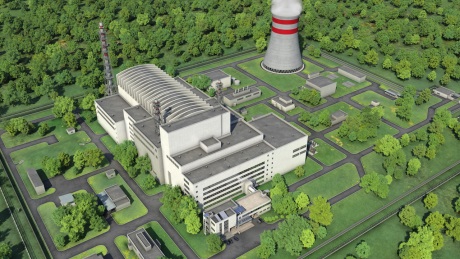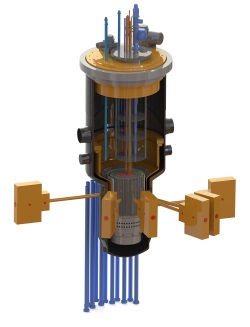Rosatom is offering "early bird" incentives to join its International Research Centre based on the multipurpose sodium-cooled fast neutron research reactor, or MBIR by its Russian acronym.
 |
| How the MBIR research complex will look (Image: Rosatom) |
Rosatom deputy director general Vyacheslav Pershukov and MBIR project director Alexander Tuzov discussed the opportunity at the International Atomic Energy Agency's General Conference in Vienna last week.
The reactor complex will be located at the site of the Research Institute of Atomic Reactors (RIAR), in Dimitrovgrad. The total, fully equipped cost is estimated to be $1 billion. Of that, the Russian budget has already provided $300 million.
The price of an "admission ticket" is calculated as a percentage of MBIR's flux, with $10 million buying 1% of access to the project. That 1% will be equal to 12 displacements per atom with a volume of one cubic decimeter each year for 20 years. From 2020 the fee will rise to $36 million.
Tuzov said the offer is not simply about attracting extra funding. "No one has ever grieved about having spare cash, but this is not the major or only reason." Pershukov added that, with financing, there is always the lender of last resort – the state budget. "Although this alternative may be more time consuming."
"In the absence of an open market indicator for fast research reactor services, we see this as a good option to involve users of the centre as investors at an early stage in order to equip the reactor from the start in accordance with the users' needs and to adequately adapt it to particular research programs," Tuzov said.
Research club
Rosatom wants a consortium, or club, of reactor users to assist with equipping the complex, as well as defining and managing its research program. In return, they will gain access to a wide range of facilities available at the RIAR site.
 |
| A model of the MBIR reactor (Image: Rosatom) |
Contributions may also be made in-kind to help speed up the process of equipping the facility, which "more than likely" will be run on a not-for-profit basis, Tuzov said. "A profitable research reactor is still a dream and a break-even scenario is more realistic."
"The nuclear research community should merge its financial, technical and research resources and switch from competition to cooperation as it does for large projects, such as the international thermonuclear experimental reactor, or ITER," he said. "Smaller projects like MBIR are no less worthy. That is why Rosatom is offering foreign access to the International Research Centre."
RIAR will be the legal owner of MBIR, performing operational and administrative functions as and when required, while the International Research Centre will be the legal entity responsible for marketing and research management.
The number of foreign participants in the centre is not so important, Tuzov said. "We aim to find strategic partners interested in the capabilities of MBIR. If there are two or ten, both options are fine."
"Potential partners have a unique opportunity of early participation in MBIR and will benefit from priority access to the world's most powerful research reactor as well as to the research infrastructure available at the RIAR site," Tuzov said. "They will be able to have a tailor-made facility adapted to their own needs. This will help them cut the cost of reactor and post-irradiation tests within their national nuclear programs."
The new centre is also an attempt to create a market for research reactor services.
"Members of the research club will be able to use their admission tickets for their own R&D programs, share it with other members in exchange for research results, or even sell it, not only to other users of the centre, but also to non-members on a case-by-case basis," Tuzov said. But only direct members will have "the full scope of voting rights" in the centre that will be similar to those of shareholders.
The centre's research staff may have an international mix of participants, but its operational staff will be Russian, according to Russian law.
The project is already in motion: Rosatom has applied for a construction licence for MBIR from the Russian regulator Rostechnadzor. "We are still in the process of finalizing the technical design, but we don't anticipate any problems and await the construction licence in May next year," Pershukov said.
"There is still enough time to proceed with international structuring of the centre, Tuzov added, since the design and construction of the reactor are covered by Russian budget funding and are in progress. Equipping the centre will follow after 2017."
Rostechnadzor granted RIAR a site licence for MBIR in July this year. The licence is valid until 25 July 2019, the same year the reactor is to be commissioned.
Technology
MBIR will replace RIAR's BOR-60, which is the world's only fast research reactor in operation. Commissioned in 1969, BOR-60 is "fully contracted till the end of its lifetime in December 2020," Tuzov said. "Long-term irradiation tests in process with BOR-60 will be transferred to MBIR."
The aggregated annual irradiation capability of MBIR exceeds that of BOR-60 four times over. Among MBIR's other advanced features are its three outside loop channels, while BOR-60 has none. That will enable parallel testing of heavy metal, sodium and gas coolants. "This will be a real luxury so far not available elsewhere," he said. "MBIR's potential applications are not limited to nuclear science, but will also prove useful for the practical needs of material engineering, nuclear medicine, and the space industry."
MBIR will use vibropacked mixed-oxide (VMOX) fuel, a Russian variant for MOX fuel production, in which blended (U, Pu) O2 and UO2 powders are loaded and compressed directly into the cladding tube. The VMOX for MBIR will have a plutonium content of 38%.
"VMOX will be produced by RIAR as we intend to save money by using existing fuel fabrication facilities there," Tuzov said. A "Plan B scenario" for MBIR fuel is a lower plutonium content, of 24%, or a uranium oxide may be used.
Alternatives, if any
"Fast reactors are the core of the Generation IV nuclear power concept, but apart from MBIR only one other is planned," Tuzov said. "The multi-purpose hybrid research reactor in Belgium will use heavy metal coolant, which makes it rather a technological challenge than a practical close alternative."
If MBIR is not commissioned in time to take over from BOR-60, nuclear science will be left with four other "distantly comparable" options. "No other country has ever mentioned the possibility of international access to their fast reactor facilities," he said. "Thus Russia’' decision to develop the MBIR research centre as an international project opens up a unique opportunity to preserve, update and extend the research infrastructure for nuclear science in its quest for reliable, safe and sustainable energy solutions."
Pershukov stressed that the project is being implemented within the Russian State Federal Program and the idea of having the International Research Centre has been approved by the government.
Researched and written
by World Nuclear News




_91467.jpg)
_47120.jpg)

_23621.jpg)





